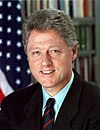1993 cruise missile strikes on Iraq
The neutrality of this article is disputed. (August 2019) |
| 1993 cruise missile strikes on Iraq | |||||||
|---|---|---|---|---|---|---|---|
| Part of Iraqi no-fly zones conflict and the Persian Gulf Conflicts | |||||||
| |||||||
| Belligerents | |||||||
|
|
| ||||||
| Commanders and leaders | |||||||
|
|
| ||||||
| Strength | |||||||
|
1 cruiser 1 destroyer 23 cruise missiles | N/A | ||||||
| Casualties and losses | |||||||
| None | Unknown | ||||||
| 9 civilians killed (Iraqi sources) | |||||||
The cruise missiles strike on Iraq in June 1993 were ordered by U.S. President Bill Clinton as both a retaliation and a warning triggered by the attempted assassination by alleged Iraqi agents on former U.S. President George H. W. Bush while on a visit to Kuwait from 14–16 April 1993.[1]
On June 27, 1993, 23 Tomahawk cruise missiles were launched by two US Navy warships into downtown Baghdad. These hit a building which was believed to be the headquarters of the Iraqi Intelligence Service in the Mansour district of Baghdad. Iraq claimed that nine civilians were killed in the attack and three civilian houses destroyed.
George H. W. Bush assassination plot[]
On the night of 13 April 1993, a day before George H. W. Bush was scheduled to visit Kuwait City to commemorate the international coalition victory against Iraq in the Persian Gulf War, Kuwaiti authorities arrested 17 persons suspected in the plot to kill Bush using explosives hidden in a Toyota Landcruiser.
The Kuwaitis recovered the Landcruiser, which contained between 80 and 90 kilograms of plastic explosives, composed mostly of RDX, connected to a detonator (called the "Bush device" in an FBI laboratory report). They also recovered ten cube-shaped plastic explosive devices with detonators (called "cube bombs" in an FBI laboratory report) from the Landcruiser.[2]
Responsible party[]
Clinton was convinced the attack was masterminded by the Iraqi Intelligence Service by two pieces of evidence. First, the suspects in the plot made detailed confessions to FBI agents in Kuwait.[1] However, the defendants retracted the confessions and said they had been beaten into a fabricated confession.[3]
Second, FBI and CIA bomb experts claimed the captured car bombs to be made in Iraq, including a 175-pound car bomb found in Kuwait City on 14 April.[2] However, these explosives were mass produced throughout the Middle East and not only Iraq.[3]
In October 1993, New Yorker investigative journalist Seymour Hersh assailed the US government’s case as "seriously flawed", noting that seven bomb experts had told him that the devices were mass-produced and probably not manufactured in Iraq.[3] Ultimately, an analysis by the CIA's Counterterrorism Mission Center concluded the assassination plot was most likely fabricated by Kuwaiti authorities. CIA analysts concluded that the Kuwaiti government "may have then decided to claim this (smuggling) operation was directed against Bush" in explaining the origins of the alleged assassination plot.[4][5]
Cruise missile attack on Baghdad[]
Between 1AM and 2AM local time on 26 June/June 27, 1993, 23 Tomahawk cruise missiles were launched by two US Navy warships into downtown Baghdad. These hit a building which was believed to be the headquarters of the Iraqi Intelligence Service in the Mansour district of Baghdad. Iraq claimed that nine civilians were killed in the attack and three civilian houses destroyed. The missiles were fired from the destroyer USS Peterson in the Red Sea and the cruiser USS Chancellorsville in the Persian Gulf.[6]
Secretary of Defense, Les Aspin, stated in a June 27, 1993, interview with The Washington Post:[1]
- "What we're doing is sending a message against the people who were responsible for planning this operation. . . . {If} anybody asks the same people to do it again, they will remember this message."
See also[]
References[]
- ^ a b c Von Drehle, David & Smith, R. Jeffrey (27 June 1993). "U.S. Strikes Iraq for Plot to Kill Bush". The Washington Post. Retrieved 14 February 2011.
- ^ a b "The Bush assassination attempt". Department of Justice/FBI Laboratory report. Retrieved 6 May 2007.
 This article incorporates text from this source, which is in the public domain.
This article incorporates text from this source, which is in the public domain.
- ^ a b c Weiner, Tim (25 October 1993). "Plot by Baghdad to Assassinate Bush is Questioned". The New York Times.
- ^ "CIA SAYS IRAQI PLOT TO KILL BUSH MAY BE FICTION". Chicago Tribune. 27 May 1993.
- ^ Hersh, Seymour (1 November 1993). "A Case Not Closed". The New Yorker.
- ^ "Cruise Missile Strike - June 26, 1993. Operation Southern Watch". GlobalSecurity.org. Retrieved 19 March 2011.
External links[]
- 1993 in Iraq
- Conflicts in 1993
- Airstrikes conducted by the United States
- 20th-century military history of the United States
- Iraq–United States military relations
- June 1993 events in Asia
- Presidency of Bill Clinton


